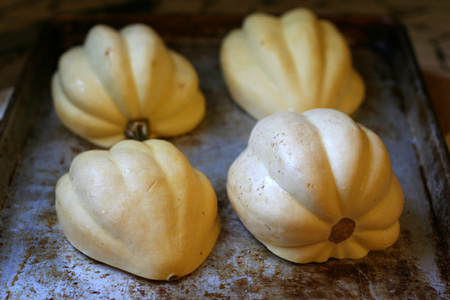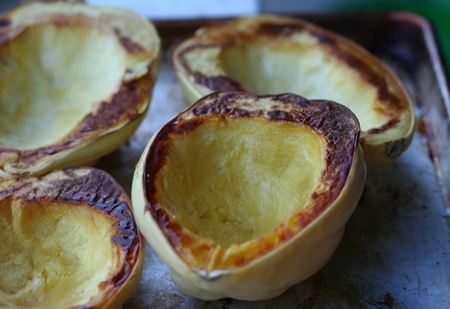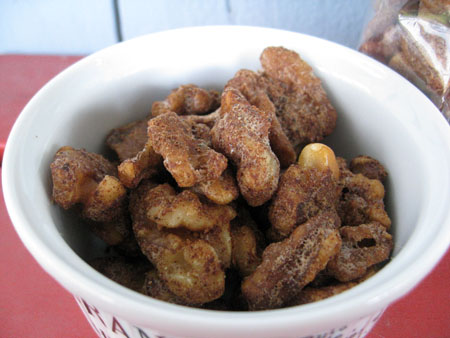
I don't often make
hors d'oeuvres but I've noticed that when I don't provide something to snack on while making Thanksgiving dinner everyone starts getting edgy and unthankful.
I'm not a person who gets up at the crack of dawn to brine a turkey, partly because the thought of shoving my hand up a dead turkey's "cavity" to remove its innards isn't something I can handle before 5pm (when the experience can be fortified with strong drinks), but mostly I don't make turkey because I'm a vegetarian. In fact, I don't labor in planning Thanksgiving dinner much at all. A day or two before my family gathers (we're a very small group) my mom and I discuss options.
This is the exception. I have been planning to make this again since I made it twice last fall. I took notes last year on the improvements I wanted to make and have been looking forward to making it again ever since.

Peeling shallots takes a lot of time. The ones from the store are
slightly easier than the ones I grow myself which have a thin dry skin
that doesn't like to come off. I made my sister do the peeling last
year so this year I performed an experiment in an attempt to improve the
tedium of peeling. Garlic roasts well in its papery skin and squeezes
out afterwords very easily, so why not roast the shallots in their skins
the same way?
I peeled all of the bigger cloves and left the rest.

Unfortunately, the experiment didn't prove successful. Yes, shallots can roast well in their skins but they are just as difficult to remove when they're sticky as when they're dry. Most importantly, the bulbs that were skinned first got browned nicely whereas the ones left in their skin were browned on the skins only. So the lesson is: peel your shallots. Even though it's a pain in the butt. Better yet, assign a minion to do the peeling.
This appetizer takes time and effort to make. It's worth it.
 Ciabatta, Caramelized Shallots, and Brie with Sour Cherry SauceIngredients:
Ciabatta, Caramelized Shallots, and Brie with Sour Cherry SauceIngredients:2 lbs of shallots, trimmed and peeled by your minion
1/2 cup olive oil
salt
pepper
Sour Cherry sauce:1 quart sour cherries, pits removed and chopped in half
4 cups sugar
(Alternatively: 1/2 jar sour cherry jam loosened up with water)
1 loaf of
Ciabatta bread (or other good quality rustic bread)
2 wedges of
Brie cheese, room temperature (
Camembert is a good substitute)
 Method:
Method:Preheat the oven to 350 degrees. Spread the shallots out on a baking sheet, drizzle all of the olive oil over them, then sprinkle with salt and grind some pepper on them. Put on a rack in the middle and bake for up to an hour and a half, making sure to turn them with a spatula every ten to fifteen minutes.
Sour Cherry Sauce:Add the sour cherries and the sugar to a medium sized sauce pan. If the cherries are frozen, let them thaw enough to start liquefying the sugar before turning the heat on. Once the cherry juice starts mixing and dissolving the sugar turn the stove on to high heat. Bring the cherries and sugar to a boil, then reduce the heat to medium and cook for 20 minutes, stirring frequently to prevent scorching. Remove from heat and let cool until everything else is ready. As it cools it will thicken.
When the shallots are done (they should be browned but not scorched, see picture above) remove them from the oven and put them in a bowl with a couple of forks for serving.
Pour the cherry sauce into a bowl and provide a spoon for serving.
Slice the Ciabatta bread in appetizer sized pieces (each slice cut in four pieces worked well for me but you can cut them bigger if you like) and arrange them on a plate.
Place the brie on a plate with knives.
If your guests are unfamiliar with or worried about the presence of fruit near their cheese and bread, go ahead and serve them up a piece before they have time to think about it.
Each piece of bread gets a generous bit of cheese, a
shallot or two, and a small spoonful of sour cherry sauce.
 Recipe Notes: If you can't get your hands on sour cherries, cranberries would make an excellent substitute. The important thing is to make a sauce that is both tart and sweet. The shallots are sweet by themselves so using a fruit that is just sweet will result in a somewhat vapid experience. A red currant sauce might be good here too. Please don't use sweet cherries. They don't work.
Recipe Notes: If you can't get your hands on sour cherries, cranberries would make an excellent substitute. The important thing is to make a sauce that is both tart and sweet. The shallots are sweet by themselves so using a fruit that is just sweet will result in a somewhat vapid experience. A red currant sauce might be good here too. Please don't use sweet cherries. They don't work.
About the rind of the cheese: I don't eat cheese rind. I will dig into a wedge of brie completely gutting it, leaving just the velvety moldy exterior like a cheese-hungry termite which has caused some gasps of shock from others. Some people view it as a crime to eschew the rind. Some simply view it as the act of a philistine. I've been told by many people that the French ALWAYS eat the cheese rind, however, I was finally gratified to find out from an actual French person that this isn't true. He said many French people don't care for the rind either and it is a question of personal taste, not a point worthy of hysteria or snobbery. I included the rind in these pictures and then fed them to my rind-eating relatives. I think the rind is picturesque and since most people I know eat it, it seemed natural to include it for the shoot.
The heat and cooking time: You can cook the shallots in less time at a hotter oven temperature but the results will not be quite as good. Less heat keeps the shallots form scorching and consequently takes longer. A good caramelization time. Give it the time. 

 This is an uncomplicated comforting soup to eat on a cold early spring day. It's warm and filling without being heavy. My mother said the pieces of bread in the soup were like eating clouds. Seriously, I'm not kidding you, she really said that. Best thing? It gets even better by the second day.
This is an uncomplicated comforting soup to eat on a cold early spring day. It's warm and filling without being heavy. My mother said the pieces of bread in the soup were like eating clouds. Seriously, I'm not kidding you, she really said that. Best thing? It gets even better by the second day. 


 Last year I learned to make Mexican style rice from a cookbook called "
Last year I learned to make Mexican style rice from a cookbook called " This picture was taken before adding the cilantro- it's very good this way too but I can't get enough cilantro so I prefer adding it in. Plus-green is pretty!
This picture was taken before adding the cilantro- it's very good this way too but I can't get enough cilantro so I prefer adding it in. Plus-green is pretty!

 Baking squash might seem too ridiculous to an experienced cook to explain but considering how many people I've met who've never baked their own pumpkin for pie, I think it's important to cover the basics. I like to think that if I died before teaching my son how to cook, he could come to my homesteading blog to learn how to do the basic things that mothers tend to teach their children in the kitchen before they ever set eyes on their first cookbook.
Baking squash might seem too ridiculous to an experienced cook to explain but considering how many people I've met who've never baked their own pumpkin for pie, I think it's important to cover the basics. I like to think that if I died before teaching my son how to cook, he could come to my homesteading blog to learn how to do the basic things that mothers tend to teach their children in the kitchen before they ever set eyes on their first cookbook. Acorn squash are usually a dark green on the exterior (the ones in these pictures are mutants from a local farmer!) and medium to light yellow on the interior. Their flesh is somewhat stringy and a little on the watery side compared to sugar pumpkins or other large squash.
Acorn squash are usually a dark green on the exterior (the ones in these pictures are mutants from a local farmer!) and medium to light yellow on the interior. Their flesh is somewhat stringy and a little on the watery side compared to sugar pumpkins or other large squash.  3. Using a strong metal spoon scrape the seeds and the most fibrous part of the squash cavity out.
3. Using a strong metal spoon scrape the seeds and the most fibrous part of the squash cavity out.  4. Place face down on a sturdy baking sheet. Preferably not a non-stick.
4. Place face down on a sturdy baking sheet. Preferably not a non-stick. 

 I don't often make
I don't often make  Peeling shallots takes a lot of time. The ones from the store are
slightly easier than the ones I grow myself which have a thin dry skin
that doesn't like to come off. I made my sister do the peeling last
year so this year I performed an experiment in an attempt to improve the
tedium of peeling. Garlic roasts well in its papery skin and squeezes
out afterwords very easily, so why not roast the shallots in their skins
the same way?
Peeling shallots takes a lot of time. The ones from the store are
slightly easier than the ones I grow myself which have a thin dry skin
that doesn't like to come off. I made my sister do the peeling last
year so this year I performed an experiment in an attempt to improve the
tedium of peeling. Garlic roasts well in its papery skin and squeezes
out afterwords very easily, so why not roast the shallots in their skins
the same way?  Unfortunately, the experiment didn't prove successful. Yes, shallots can roast well in their skins but they are just as difficult to remove when they're sticky as when they're dry. Most importantly, the bulbs that were skinned first got browned nicely whereas the ones left in their skin were browned on the skins only. So the lesson is: peel your shallots. Even though it's a pain in the butt. Better yet, assign a minion to do the peeling.
Unfortunately, the experiment didn't prove successful. Yes, shallots can roast well in their skins but they are just as difficult to remove when they're sticky as when they're dry. Most importantly, the bulbs that were skinned first got browned nicely whereas the ones left in their skin were browned on the skins only. So the lesson is: peel your shallots. Even though it's a pain in the butt. Better yet, assign a minion to do the peeling. Ciabatta, Caramelized Shallots, and Brie with
Ciabatta, Caramelized Shallots, and Brie with  Method:
Method: Recipe Notes: If you can't get your hands on sour cherries, cranberries would make an excellent substitute. The important thing is to make a sauce that is both tart and sweet. The shallots are sweet by themselves so using a fruit that is just sweet will result in a somewhat vapid experience. A red currant sauce might be good here too. Please don't use sweet cherries. They don't work.
Recipe Notes: If you can't get your hands on sour cherries, cranberries would make an excellent substitute. The important thing is to make a sauce that is both tart and sweet. The shallots are sweet by themselves so using a fruit that is just sweet will result in a somewhat vapid experience. A red currant sauce might be good here too. Please don't use sweet cherries. They don't work. 


 How to make a roux:
How to make a roux:




![Reblog this post [with Zemanta]](http://img.zemanta.com/reblog_e.png?x-id=a2ac9a37-db27-47dc-9657-a5c2f58a7fe8)

![Reblog this post [with Zemanta]](http://img.zemanta.com/reblog_e.png?x-id=25bfa04f-5b1c-4a14-8759-88039d0fe084)










Recent Comments